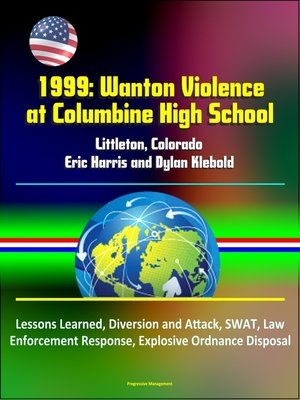1999
ebook ∣ Wanton Violence at Columbine High School--Littleton, Colorado, Eric Harris and Dylan Klebold, Lessons Learned, Diversion and Attack, SWAT, Law Enforcement Response, Explosive Ordnance Disposal
By Progressive Management

Sign up to save your library
With an OverDrive account, you can save your favorite libraries for at-a-glance information about availability. Find out more about OverDrive accounts.
Find this title in Libby, the library reading app by OverDrive.



Search for a digital library with this title
Title found at these libraries:
| Loading... |
This excellent report has been professionally converted for accurate flowing-text e-book format reproduction. In an effort to share with others the lessons learned from his department's experience at the Columbine High School tragedy, Chief William Pessemier of the Littleton, Colorado Fire Department requested that the United States Fire Administration (USFA) assist the department in conducting a post-incident analysis of the event and in documenting the fire and emergency medical services response.
This report is an analysis of the fire service and emergency medical service (EMS) operations and the overall response to the assault on Columbine High School at Littleton, Colorado, on April 20, 1999. Incident command, special operations, and mass casualty emergency medical services are featured.
In any major incident, the efforts of all public safety personnel are inexorably linked. However, this report does not address the overall law enforcement operations, or the concurrent operations of various police commands, the special weapons and tactics (SWAT) teams, or the explosive ordnance disposal (EOD) units. The Jefferson County Sheriff's Office issued a formal report and has released surveillance video and radio transmissions that provide additional information on law enforcement's efforts during this incident.
For this report, USFA conducted a comprehensive review of internal documentation and interviewed many of the key public safety personnel. Media reports and journal articles also provided insight. Information was gleaned from the timelines of the three dispatch centers: Littleton Police, Littleton Fire/EMS, and Jefferson County Sheriff. These, in turn, were compared and reviewed against the collection of eyewitness accounts and first-responder interviews to capture a reasonable picture of the violent rampage and its impact. Understandably, there are some inconsistencies among the sources of information as to the chronology of events. For this report, the events were reconstructed based on documentation from the primary response agencies.
Near midday on Tuesday, April 20, 1999, the staff and students of Columbine High School in Littleton, Colorado, became targets of yet another U.S. episode of wanton violence. The events of that day shocked the nation as two juvenile offenders carried out a premeditated assault and victimized occupants of the school. Thirteen defenseless individuals were slain, and over 160 students and faculty were triaged — 24 with serious injuries. The two offenders, both Columbine High School students, maniacally unleashed an unprecedented terrorist-style assault using numerous semiautomatic weapons and nearly 100 improvised incendiary and explosive devices. The latter were designed as antipersonnel devices intended to inflict casualties, including harm to responding emergency personnel.
Lessons Learned Summary * Description of Community * Littleton Fire District -Service Area * Littleton Fire Department — Service Profile * Emergency Medical Services * Littleton Police Department * Littleton Fire and Police Communications * Jefferson County Sheriff's Office * Jefferson County School District * Columbine High School * The Diversion * The Attack * The Response * Law Enforcement/SWAT/EOD * EOD Operations * Mutual-Aid Response * Hospital Services * Observations and Lessons Learned * Joint Forces: Unified Command for Major Incidents * Fire Service Operations in a Dynamic, Violent Environment * Communications * Emergency Medical Services * Operations * Additional Lessons * Technologies that Enhance Response * Surveillance and Security * Command, Control and Communications * Detection,...






